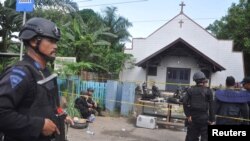Last Sunday’s “lone wolf” terror attack at a church in Samarinda, East Kalimantan, seemed like another random act of Islamic State-endorsed violence. A 32-year-old perpetrator killed a toddler and injured three others with homemade bombs at Oikumene Christian Church. Although the attack seems arbitrarily violent, it was actually premeditated. And the perpetrator is linked to a homegrown extremist network and the prison system, both major factors in his radicalization.
“Those involved in the Samarinda church attack come from an IS-linked group called Jamaah Anshorud Daulah (JAD),” said Muh Taufiqurrohman, of the Center for Radicalism and Deradicalization Studies. JAD is linked to IS through an Indonesian, Salim Mubarok Attamimi, (a.k.a Abu Jandal) who has close ties with IS central leadership and who leads an Indonesian splinter unit called Katibah Masyaari, or Forces of the East.
The prime suspect in the Samarinda attack is Jo “Joh” Bin Muhammad Aceng Kurnia, a man who spent three years in jail from 2012 to July 2014 for his involvement in a plot to blow up a research center and church in Banten, Java, according to the Jakarta Post. He was released on parole before serving his full 42 month sentence.
Taufiqurrohman said JAD members were claiming retroactive responsibility for the Samarinda attack on Telegram message channels. “They even encouraged IS supporters outside Samarinda to attack [Jakarta governor] Ahok, [Indonesian president] Jokowi and the head of Indonesian National Police,” he said.
It is an indication of how the current sectarian tension in Indonesia around Jakarta’s ethnic Chinese governor is linked to general Islamic terrorism.
The two hard-line Islamist movements of IS sympathizers and the reactionaries calling for Ahok’s imprisonment are feeding off each other, said Achmad Sukarsono, an analyst with the U.S.-based political-risk advisory firm Eurasia Group.
“I think there’s a heightened threat of terror attacks until the gubernatorial elections are over, either in February or, if there’s a runoff, in May,” he said. “It seems random, but once the election concludes, there’s no strong political motivation for hard-line Islamists of all stripes.”
Pre-IS roots
The roots of JAD’s network go even further than IS. “Between 1999 and 2009, Jemaah Islamiyah [the Southeast Asian terrorist group] was highly active, but they were broken down by Indonesian security forces and splintered,” said Sukarsono. “Now several splinter groups of JI want to resurrect their clout, and they see IS as an opportunity to reinvigorate their movements. This guy is a foot soldier of one of those splinter groups.”
The bridge between the JI era and the current generation of terrorists was, in this and many other cases, prison time.
Terrorists inmates have “a certain position in jail,” said Sukarsono. “They’re venerated, in a way; they’re not punished, and their ideas get reinforced.” When radicalized prisoners like Joh leave prison, he said, they don’t immediately find jobs and become disillusioned.
“This guy had to become a construction worker again just to make ends meet,” said Sukarsono. “He’s exactly the type of disillusioned person who found new motivation in IS.”
In a chilling parallel, IS declared its so-called caliphate during Ramadan 2014, and Joh was released from prison on parole on Eid al-Fitr, the feast marking the end of that same Ramadan.
Sectarian tensions
But why East Kalimantan, a region with scant extremist links? That too is not as arbitrary as it first seems. Samarinda has a sizable Christian minority of about 75,000 people, or eight percent of its population. Targeting a church would create sectarian conflict between Muslims and Christians in the region, University of Indonesia terrorism expert Ridwan Habib told the Jakarta Post.
It’s worth noting that the family members of bomb victims have resolutely avoided falling for this bait, endorsing forgiveness and due process of law to prosecute the attacker.
The Samarinda attack happened just days after IS leader Abu Bakr al-Baghdadi released a rare audio message rallying jihadists around the world to action, as Iraqi troops closed in on Mosul. While the message seems to have come straight from the top, there is no central pro-IS leadership within Indonesia, as Nava Nuraniyah of the Institute for Policy Analysis of Conflict has written.
“As it becomes more difficult to get to Syria, many IS supporters are frustrated and impatient for action and may be more motivated than ever to revert to a do-it-yourself jihad,” writes Nuraniyah.
Monitoring
While attacks like the one in Samarinda can seem hopelessly random, that doesn’t posit blind resignation. One reasonable line of defense would be a clear database of terrorists, including low-level ones like Joh was until recently, suggested Sukarsono.
“The BNPT has something in place, but it’s not updated regularly,” he said. “Unfortunately, monitoring is not exactly sexy. It doesn’t involve showing off new weapons or gear, or doing press conferences.” And, of course, the burden of proof is negative; the measure of success would be no incident.
Still, when lone wolf attackers have such salient risk factors as did the Samarinda attacker, it would be well worth the unexciting effort to improve the tracking of likely perpetrators.







